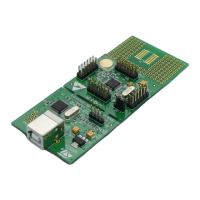8-bit basic timer (TIM4, TIM6) RM0016
244/449 Doc ID 14587 Rev 8
19.2 TIM4 main features
The main features include:
● 8-bit auto-reload up counter
● 3-bit programmable prescaler which allows dividing (also “on the fly”) the counter clock
frequency by 1, 2, 4, 8, 16, 32, 64 and 128.
● Interrupt generation
– On counter update: Counter overflow
19.3 TIM6 main features
The main features include:
● 8-bit auto-reload up counter
● 3-bit programmable prescaler which allows dividing (also “on the fly”) the counter clock
frequency by 1, 2, 4, 8, 16, 32, 64 and 128.
● Synchronization circuit to control the timer with external signals and to interconnect
several timers (See Section 17.4.6 on page 157).
● Interrupt generation
– On counter update: Counter overflow
– On trigger input
19.4 TIM4/TIM6 interrupts
The timer has 2 interrupt request sources:
● Update interrupt (overflow, counter initialization)
● Trigger input (TIM6 only)
19.5 TIM4/TIM6 clock selection
The clock source for the timer is the internal clock (f
MASTER
). It is connected directly to the
CK_PSC clock that feeds the prescaler driving the counter clock CK_CNT.
Prescaler
The prescaler implementation is as follows:
● The prescaler is based on a 7-bit counter controlled through a 3-bit register (in the
TIMx_PSCR register). It can be changed on the fly as this control register is buffered. It
can divide the counter clock frequency by any power of 2 from 1 to 128.
The counter clock frequency is calculated as follows:
f
CK_CNT
= f
CK_PSC
/2
(PSCR[2:0])
The prescaler value is loaded through a preload register. The shadow register, which
contains the current value to be used, is loaded as soon as the LS byte has been written.
Read operations to the TIMx_PSCR registers access the preload registers, so no special
care needs to be taken to read them.

